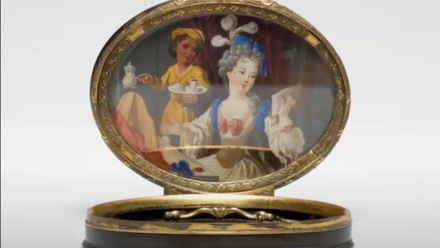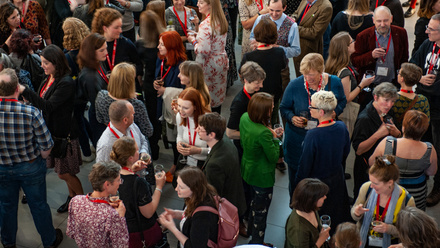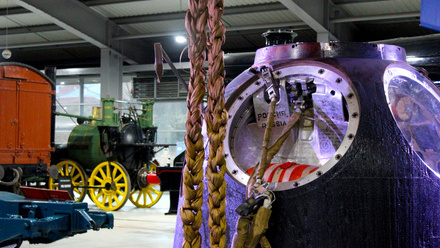A new handbook published earlier this year by creative consultancy Music found that while neurodiversity is largely valued in creative spaces, few workplaces have environments and practices in which neurodiverse workers can thrive. The handbook outlines how the creative industry can best embrace neurodiversity. A free online workshop on 19 October hosted by Digital Heritage Lab will also seek to support the sector in understanding neurodiversity and creating accessible and inclusive spaces.
Read Lucy’s inspiring story below on how she reached her fullest potential at work and overcame barriers associated with dyslexia:
Neurodiversity and Me
I opened my email and saw a message I had been waiting for. It was a 6 week wait (which seemed an eternity) but when I saw it, I hurriedly opened the attachment, scrolled through the report and read the sentence-
"We conclude that, due to the nature of Lucy’s within attainment tasks in comparison with Lucy’s overall intellectual abilities, Lucy has a specific learning difficulty- dyslexia. We would describe this as mild to moderate in severity. Lucy also showed signs associated with Visual Stress (Meares Irlen Syndrome)."
Although it was the confirmation that I desperately needed, it was a strange feeling reading those sentences. I read it over and over thinking the more I read it the more I would understand what being dyslexic meant. I was 28 years old with very little understanding of what dyslexia even was.
Up to that point, I had always felt different from my peers. They could read at speed with ease. They could take notes. They could spell. They remembered names and phone numbers. They knew how to use a semi colon!
I on the other hand would be re-reading sentences over and over. I struggled to take meaningful notes. Spelling was a nightmare, if Word couldn’t correct a misspelt word, I would try and Google it and if that didn’t work, I’d give up and use a word I knew how to spell which I knew would not be as good. My working memory is appalling, trying to remember new people’s names and phone numbers was and still is a nightmare.
I had felt slow, stupid with an added dose of imposter syndrome. It was only when I started learning to drive, struggled with changing gears and following all the processes that I was told that maybe I was dyslexic and should get tested. It was only then that I thought maybe I am not stupid, maybe there is a reason why I struggled with so many things that felt like they should be basic and easy.
Neurodiversity is the concept that neurological differences such as Dyslexia are recognised and respected as any other human variation, it is not a medical condition to be cured or ‘fixed’
After receiving my diagnostic report, I naively thought that the support for dyslexia would be instant. That sadly was not the case. I started a new job in May 2016. I clearly stated in the application form under disabilities, (yes dyslexia is classed as a disability although it is hidden!) prior to this that I was dyslexic, but no adjustments were made at the interviewing stage although admittedly I wouldn’t have known what to ask for! I luckily did manage to get the job despite how challenging I found interviewing.
When I started the job, after a few days I had a meeting with my manager who said Occupational Health had been in touch and said I was fit for work. That was it. I was sitting there thinking surely, I need adjustments, I had my report that said as much. How come I was treated just like my other colleagues?!
A few months went by and nothing happened. I then began to feel I was really struggling. Although the output of my work was fine, I felt tired and stressed by it. Although my new job was a step up in terms of responsibility, it required far more reading and writing than any job I had before. Most conservation jobs I had previously were more practical and played more to my strengths.
It was only when a colleague noticed that I felt overwhelmed by some of the work set that we had a chat and I explained where I felt I needed extra help. We then chatted to my manager and she went to HR to ask how to best support me. This was a back and forth of which went on for far longer than I feel it should have. This was almost certainly due to a lack of awareness around neurodiversity within workplaces and how best to support employees. If I was struggling to understand how best to help me; how can I therefore be able to advise other colleagues on how best to help me if they are unaware of these issues and how dyslexia impacts individuals?
There are also things other colleagues can do to help with working practises such as someone taking minutes at all meetings, formatting Excel spreadsheets so all alternative rows are a different colour, using sans serif fonts...
Although it was a long time after I started, by February 2018 I finally received the workplace adjustments I so desperately needed complete with full training thanks to an Access to Work grant. Adjustments included software such as Dragon Naturally Speaking so I can dictate what I want to write, Read and Write Gold- this is a software which allows Word documents, emails, webpages etc. to be read aloud, has a far superior spell checker compared with Word as well as research tools.
I also received a new Dictaphone to help with notetaking. The Dictaphone has the added benefit of software which translates any recording into written text using Dragon. As well as software I was taught coping strategies and how to work better such as using mind-maps, switching off email alerts and having a separate room to work in so I do not get distracted.
There are also things other colleagues can do to help with working practises such as someone taking minutes at all meetings, formatting Excel spreadsheets so all alternative rows are a different colour, using sans serif fonts, providing agendas for all meetings in advance as well as allowing me enough time to write down information such as phone numbers.
Whilst experiencing all of this I made it my business to understand more about my Dyslexia and Meares Irlen Syndrome. That is when I discovered the term Neurodiversity. Neurodiversity is the concept that neurological differences such as Dyslexia are recognised and respected as any other human variation, it is not a medical condition to be cured or ‘fixed’. Neurodiverse differences also include Dyspraxia, ADHD, Dyscalculia amongst others.
Two people who have dyslexia may not experience it in the same way and therefore may need different adjustments to reach their full potential.
Neurodiverse differences also overlap, so a dyslexic person may have some symptoms of ADHD, another Dyslexic person may have some symptoms of Dyspraxia. Therefore, having a diagnostic report is important. It is personalised and indicates what an individual’s strengths and weaknesses are. Two people who have dyslexia may not experience it in the same way and therefore may need different adjustments to reach their full potential.
Since being diagnosed my life has changed for the better and once I had the adjustments in place, I was and am able to achieve my full potential at work. I have learned that working practices do not need to be a one size fits all and there are many ways of being able to achieve good results. It does not need to be the case that one must suffer in silence desperately trying to adapt to work in the typical way as it has always been done.
A study conducted by a dyslexia charity estimates that 75% of people with dyslexia were only diagnosed after the age of 21. They believe that around 2.9 million workers in the UK live with dyslexia and more than 50% of adults try to hide it. It is estimated that 1 in 7 people has some form of neurodiversity.
Although talk of workplaces needing to become more diverse and more representative of the general population has gained pace, it is vital that all workplaces look at their recruitment and working practices to see that they do not disadvantage groups protected by the Equality Act 2010. Although the word ‘Equality’ is talked about a lot, this does not address the barriers that disadvantaged groups face. If everyone is treated in exactly the same way, those disadvantaged groups will still have their own unique barriers that they have to overcome to achieve the same results. Therefore, it is not fair to treat everyone in the same way and by doing this we are in fact discriminating against various groups.
We need to create more equitable working practices which address the barriers disadvantaged groups face from the initial stages of the application form all the way through to being in post in a job. We all need to have a mindset of Equity- It is simply giving more to those who need it, which is proportionate to their own circumstances, in order to ensure that everyone has the same opportunities. If equality is the end goal, equity is the means to get there.
If you would like to learn more about Dyslexia and Neurodiversity, I would recommend the following-
Icon is for everyone! We welcome everyone with a passion for cultural heritage. Join us today.
---
Image: Photo by Alina Grubnyak on Unsplash






